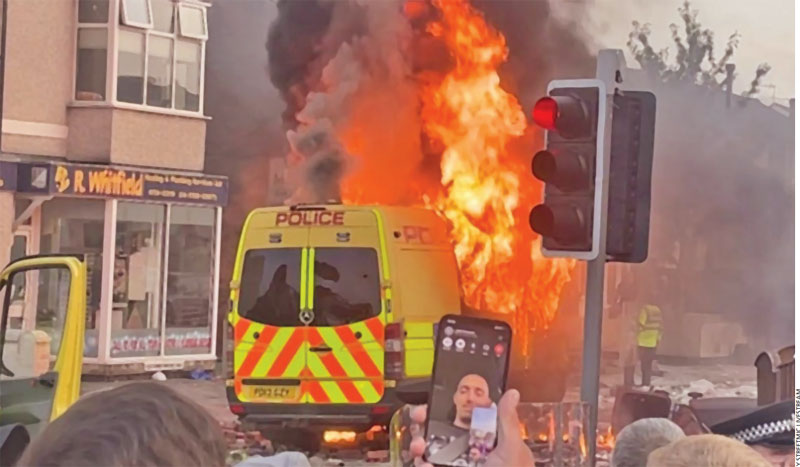As Europe declines, Global South rises
 Maj. Gen. Atanu Pattanaik
Maj. Gen. Atanu Pattanaik
The widespread street violence in London and other cities and towns across the United Kingdom (UK) since the beginning of August riots, following a fatal knife attack killing three young girls in Southport led to the burning of police patrol cars, arson, looting and torching of shops, and violent face-offs with police as well as rival anti-riot protest groups. Generally associated with third world countries, these riots open a new chapter in the decline of what once was the largest colonial empire in human history. If this was confined to the UK alone, it could have been explained away. Arson and sabotage of railway communications on all train routes leading to Paris just as it was decked up to inaugurate the 2024 Olympics, stranding hundreds of thousands of commuters including athletes taking part in the Olympics, takes the debate to a different plane.
Europe enjoyed rapid economic growth post the industrial revolution in the eighteenth century and stayed the epicentre of prosperity till the emergence of the United States (US) towards the end of World War I as the most dominant economic powerhouse. The two world wars caused massive devastation in Europe. It was the American Marshall Plan that helped Europe not only rebuild but also turbocharge its economy to regain primacy in the overarching umbrella of the European Union (EU). That golden run of six to seven decades came to an end with the global economic meltdown in 2008. Since then, there have been constant headwinds that have chipped away at the economic heft and cultural vibrancy of Europe.
The long running differences between members of EU over a range of issues including gay rights, abortion, climate action impacting its farmers, illegal migration, support for Ukraine as well as disputes over the role of the EU bureaucracy are out in the open. Italy is at the frontline of the migration crisis as thousands from North Africa take dangerous boat rides across the Mediterranean to wash up on its shores every day. Members like Hungary and Slovakia are taking extreme positions within Nato (North Atlantic Treaty Organisation) such as opposition to despatch troops on ground to support Ukraine’s failing war efforts. There are deep fissures developing within the EU as well as in Nato as Europe faces headwinds, one after another on multiple fronts, especially since decoupling from cheap, clean and reliable Russian energy in February 2022.
The Rise of Europe
The industrial revolution propelled Europe to emerge as a significant and consequential economic and military power. Until then, China and India, as two of the most expansive, settled and old civilisations, contributed up to 70 per cent of the global economy. For thousands of years, economic progress was largely linear and linked to population growth. Without machines or technological innovations, one person could only produce so much with their time and resources. At the turn of twentieth century, Europe including Czarist Russia which associated itself more closely to Europe than Asia, contributed to almost half of the global economic output.
Taken together with the American enterprise which emerged in tandem with Europe, they produced over 70 per cent of the global GDP by the time World War II ended. Much of the European continent was left devastated, its cities in ruins, its population exhausted and bewildered, and its economy in shambles. Gradually gone were the milch cows, the vast colonial empires that contributed to the coffers of countries such as Britain, France, the Netherlands, Belgium, Portugal and Spain, as much through plunder and loot as from upfront trade and commerce.
After the devastation caused by World War II, Europe could bounce back, initially with the generosity of the US through the Marshall Plan. But that is only part of the story. Two major external factors that helped Europe recover and thereafter embark on a heady growth path have revealed themselves; financial loot perpetrated through offshore tax havens established by the British as colonies gained freedom, and resource loot through exploitative arrangements entered by France while exiting its colonies in Africa. In a sense, imperialism never ended, it only changed form as Europe invented newer ways and means to exploit the global South.

Nato and The Marshall Plan
The despair and destruction pervading the European continent posed great challenges to the European leadership post World War II. The US emerged unscathed from unlike Europe and Russia which were devastated and in ruins. Consequently, the US flexed its newfound superpower status to take control of Europe through the twin instruments of Nato and the Marshall Plan (officially the European Recovery Program or ERP) which while helping rebuild Europe also took control of its governing institutions. Succour came through the Marshall Plan, which played a major role in the economic recovery, modernisation and unification of Europe. In three years between 1948-51, the ERP gave away USD 12.4 billion (about 5 per cent of the 1948 American GDP of USD 270 billion) for modernising the economic and financial systems and rebuilding the industrial and human capital of war-torn Europe, including Britain, Germany, France, Italy and smaller nations. The money was not a loan and there was no repayment.
German engineering and automobile industry, British banking and insurance as well as its London Metal Exchange, French nuclear technology, defence industry and avant garde fashion brands, Denmark’s dairy, Scandinavia’s timber, marine products and ship building and Italian fashion houses and fast cars made names for themselves.
On the security front, Europe came to realise the consequences of extreme nationalism that ignited the war and chose to embrace a collective security architecture. Nato was created on 4 April 1949, as a counterweight to the Soviet armies stationed in central and eastern Europe after World War II. Article 5 is the cornerstone of Nato and states that an attack on one member of Nato is an attack on all of its members. Six years later, on 14 May 1955, the Warsaw Pact took shape, the immediate trigger being the Paris agreement among the Western powers admitting West Germany to Nato. The Soviet Union dramatically collapsed, and the Warsaw Pact formally declared ‘non-existent’ at a final summit meeting of leaders in Prague, Czechoslovakia on 1 July 1991.
After the demise of the Soviet Union, dissolution of the rival Warsaw Pact, and with the successor state Russia on the verge of bankruptcy in the late Nineties, it was logical to expect Nato to wind up too. But exactly the opposite happened. Nato has not stopped expanding since, growing from 17 countries in 1990 to 34 today. But it is staring at a bleak future as it celebrated 75 years of existence. It is faltering in its mission to safeguard Europe, even as despite Nato’s comprehensive support, Ukraine continues to struggle in the war against Russia. The gnawing economic slide leaves little room for increasing defence spending. The newest Nato member Sweden recently announced that the Riksbanken, its central bank, had lost some 44 billion Kroner (Euro 3.2 billion) or half its defence budget, and needed that much money from the state just to stay afloat. Most Nato members except Turkey have boutique armies with a few brigades barely capable of showing the flag in multinational operations. But Turkey, with the second largest military in Nato after the US, sits on the fence while anti-Gaza war protests roil the streets.
Meanwhile, the forces arrayed on the other side are rallying their informal alliance, much to the discomfiture of Europe. Energy and commodity rich former super power Russia, world’s second largest economy and global manufacturing hub China, radical and oil-rich Iran coalesce with rogue elements like nuclear armed North Korea and jihadists-packed Yemen to put Nato on notice.
You must be logged in to view this content.

